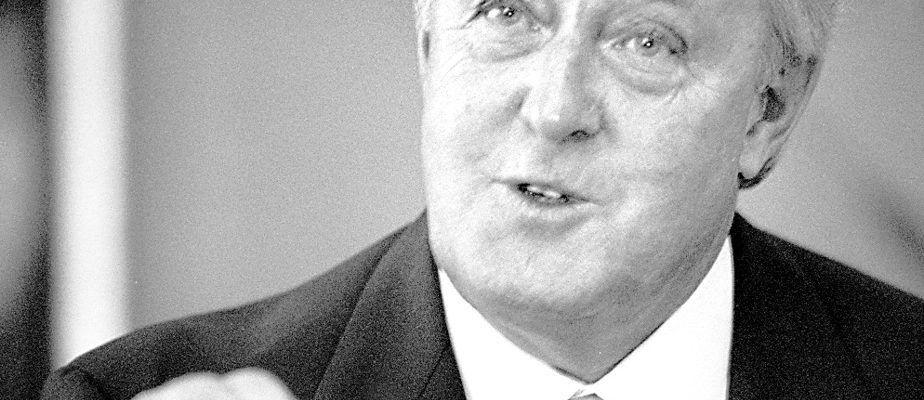Retrocession of land to Mirabel (1985)

PHOTO FRANÇOIS ROY, LA PRESSE ARCHIVES
Montreal-Mirabel International Airport
On March 27, 1969, Ottawa announced its choice of Sainte-Scholastique (now Mirabel) to build the new Montreal international airport. As a result, 97,000 acres of agricultural land are expropriated, disrupting the lives of thousands of people. The return of 80,000 acres of land on March 27, 1985, will be one of the first achievements of the Mulroney government. In December 2006, under the Harper government, 11,000 more acres were returned.
Wave of privatizations (1985-1993)

PHOTO MARTIN CHAMBERLAND, LA PRESSE ARCHIVES
In the late 1980s, Brian Mulroney’s government privatized Air Canada.
As soon as it took office, the Mulroney government embarked on a wave of privatization of state corporations. A Minister of State for Privatization, Barbara McDougall, will even be appointed. From 61 companies when the Conservatives arrived, the number dropped to 55 in April 1987. Added to this were the privatizations of Air Canada (1988-1989) and Petro-Canada (15% in 1991). De Havilland, Canadair, Teleglobe are among the companies sold.
Fight against apartheid (1985)

PHOTO CHUCK MITCHELL, CANADIAN PRESS ARCHIVES
Brian Mulroney and Nelson Mandela, upon the latter’s arrival in Ottawa, June 17, 1990, for a three-day visit to the country
On December 20, 1984, after receiving the Nobel Peace Prize, South African Bishop Desmond Tutu was welcomed by Brian Mulroney in Ottawa. In October 1985, the Prime Minister made a notable anti-apartheid speech at the UN. A speech described by diplomats as “unusual for a white leader of the Western bloc”, according to The Press. Visiting Canada in June 1990, Nelson Mandela thanked Canadians for their support. June 30, 1991 marked the end of apartheid in South Africa.
Meech Lake Accord (1987)

PHOTO FRED CHARTRAND, CANADIAN PRESS ARCHIVES
Prime Minister Brian Mulroney taking a walk outside the conference center where the Meech Lake Accord negotiations were taking place, in Ottawa, June 1990
Brian Mulroney made the return of Quebec to the Constitution with “honor and enthusiasm” a key moment of his 1984 electoral campaign. In the spring of 1987, the negotiations of the Meech Lake Accord recognizing Quebec as a “distinct society” led to the agreement of June 23, 1987. But after three years, there is no unanimous ratification of the provinces. By referendum on October 26, 1992, Canadians also rejected the Charlottetown Accord, a second attempt to find common ground.
Canada-US Free Trade Agreement (1988)

PHOTO ARMAND TROTTIER, LA PRESSE ARCHIVES
The President of the United States, Ronald Reagan, visiting Quebec in March 1985, alongside the Prime Minister of Canada, Brian Mulroney.
If the question of Canada-United States free trade was at the heart of the 1988 election campaign, Brian Mulroney was already talking about it in 1984. Good thing, his American counterpart, Ronald Reagan, was also in favor of it. On January 2, 1988, after a year of negotiations between the two countries, the agreement was signed. The treaty gained momentum with the accession of Mexico to a North American treaty (NAFTA) signed on December 17, 1992.
Canadian Space Agency

PHOTO IVANOH DEMERS, LA PRESSE ARCHIVES
The John H. Chapman Space Center, headquarters of the Canadian Space Agency, in Longueuil
June 1988. Lucien Bouchard, Secretary of State and close friend of Mulroney, is committed to ensuring that the Montreal region obtains the headquarters of the future Canadian Space Agency. This will indeed be the case. The organization is created on 1er March 1989 and the John H. Chapman Center was built in Longueuil. The ASC is still in operation and one of its astronauts, Jeremy Hansen, will participate in Artemis II, the first manned lunar mission since Apollo 17 in December 1972.
Adoption of the GST (1991)

PHOTO ROBERT SKINNER, LA PRESSE ARCHIVES
The GST still exists, but former Conservative Prime Minister Stephen Harper reduced it to 5%.
The entry into force of the goods and services tax (GST) is undoubtedly one of the most criticized legacies of the Mulroney era. Set at 7%, the tax comes into force on 1er January 1991. Initially, Finance Minister Michael Wilson had set it at 9%, but he backed down in the face of discontent. The GST still exists, but former Prime Minister Stephen Harper reduced it to 5%.
Commission of Inquiry on Aboriginal Peoples (1991)

PHOTO BERNARD BRAULT, LA PRESSE ARCHIVES
Iqaluit, Nunavut
Following the Oka Crisis in the summer of 1990, the Mulroney government created a Royal Commission on Aboriginal Peoples, charged with examining the economic, social and cultural situation of the communities. The announcement was made on April 23, 1991 at the First Nations Congress in Victoria. A report was submitted in November 1996. Let us also remember that Nunavut was officially created on May 25, 1993 following a visit by Mr. Mulroney to Iqaluit.
Canada-US Acid Rain Treaty (1991)

PHOTO EDOUARD PLANTE-FRÉCHETTE, LA PRESSE ARCHIVES
Even though we talk about it less, acid rain remains under surveillance today.
In March 1985, the Mulroney government announced a program to combat acid rain. But since rain has no borders, it’s a good idea to talk to your neighbor about it, especially if it’s the United States. On March 13, 1991, a treaty on air quality and cross-border pollution was signed between Mr. Mulroney and President George WH Bush. Even though we talk about it less, acid rain remains under surveillance today.
